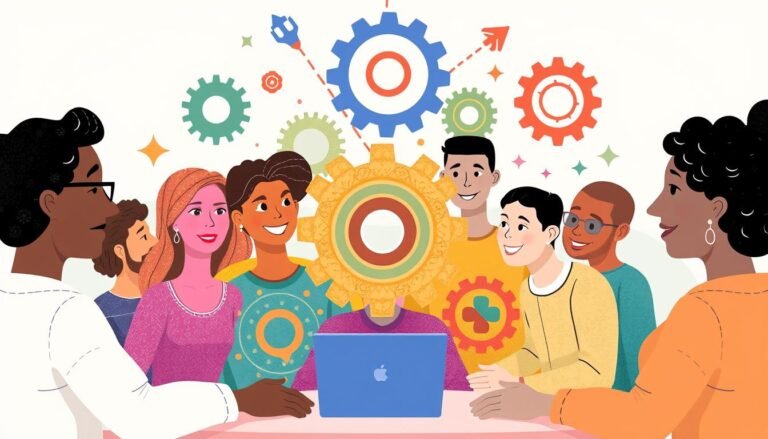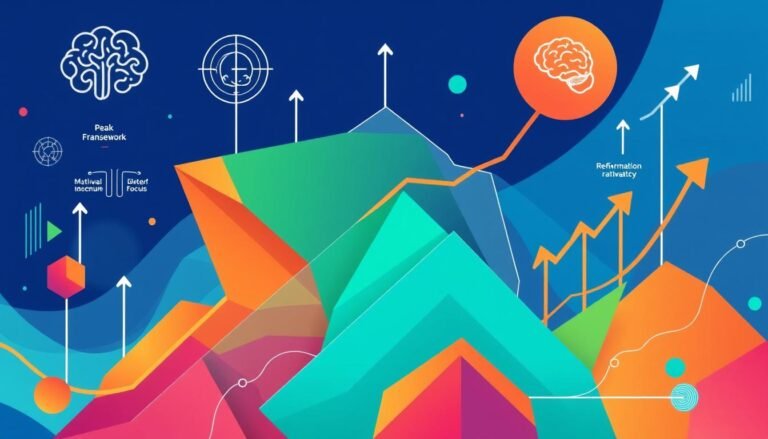Achievement Motivation Psychology
Achievement Motivation Psychology explores why some people strive for success while others don’t. It’s not just about being smart or talented. It’s about the inner drive that pushes us to achieve.
This field studies how we set and chase our goals. It’s closely linked to Self-Determination Theory. This theory says we’re most motivated when we control our choices. Doing things because we want to, not because we have to, is crucial to success.
Our motives can be hidden or clear. Sometimes, we’re driven by needs we’re not even aware of. Other times, we know exactly what we want. These different motives can work together or clash, affecting how we feel about our achievements.
Understanding Achievement Motivation Psychology can change the game. It helps explain why some students excel while others struggle. By exploring these insights, we can boost our own drive and help others reach their goals.
Key Takeaways
- Achievement motivation involves both hidden and visible drives
- Self-Determination Theory links to achievement through intrinsic motivation
- Early childhood experiences shape our achievement motives
- Goal-setting plays a crucial role in motivating achievement
- Cultural differences can impact how achievement motivation manifests
- Measuring achievement motivation helps predict future success
Understanding Achievement Motivation Psychology: Core Concepts
Achievement Motivation Psychology looks into what drives us to achieve. It asks why some people aim for greatness and others don’t. Let’s explore the main ideas that help us understand this field.
Definition and Historical Origins
Achievement motivation is the drive to excel and reach high goals. It started in the late 1930s with Henry Murray. David McClelland and John Atkinson built on this in the 1950s, making it a key part of motivational psychology.
The Role of Achievement Motivation in Human Behavior
Achievement motivation shapes how we act. It affects our task choices, how we handle challenges, and our effort levels. Those with high achievement motivation seek tough goals and keep improving.
Key Theoretical Foundations
Several theories are at the heart of Achievement Motivation Psychology. The Achievement-Goal Theory, from the late 1970s, divides goals into two types. It shows why some people focus on getting better (intrinsic motivation) and others on showing they’re good (extrinsic motivation).
| Goal Type | Focus | Motivation Type |
|---|---|---|
| Mastery Goals | Personal improvement and learning | Intrinsic Motivation |
| Performance Goals | Demonstrating competence and comparison | Extrinsic Motivation |
Knowing these key ideas in Achievement Motivation Psychology helps us set better goals. It shows how to grow personally and professionally. By understanding both intrinsic and extrinsic motivation, we can find our way to success and happiness.
The Dual System of Motivation: Implicit vs Explicit
Achievement motivation comes from two main systems: implicit and explicit. These systems guide our goals and actions in different ways. They affect our self-confidence and how we approach challenges.
Implicit Motivational System Characteristics
Implicit motives start early in life and work without us even realizing it. They connect to our natural behaviors and feelings. A study with 141 people showed that these motives help us remember specific, emotional moments.
Explicit Motivational System Features
Explicit motives are something we’re aware of and are shaped by what others expect of us. They’re measured through surveys and are linked to our overall self-image. These motives are key in setting goals and building our self-confidence.
Neural Mechanisms Behind Both Systems
Research points to different brain parts for implicit and explicit motives. A study with 82 managers found that when these systems don’t match, it can weaken our willpower. It also affects how happy we feel.
| Motive Type | Development | Influence on Behavior | Memory Association |
|---|---|---|---|
| Implicit | Early life | Spontaneous, pleasurable | Specific, emotional events |
| Explicit | Socially influenced | Conscious, goal-directed | General, self-descriptive |
Knowing about these two systems can help us match our inner and outer drives. This could improve our approach to challenges and our success in achieving goals.
Neuroscience of Achievement Motivation
The brain plays a big role in our drive to achieve. Recent studies using fMRI have uncovered how our brains react to motivational signals.
Research shows that different brain parts light up for implicit and explicit motives. The implicit motive, tied to Competence Motivation, gets areas linked to emotions and seeing things. On the other hand, the explicit motive, linked to Performance Motivation, gets areas for thinking and words.
A study from Vanderbilt University found dopamine’s key role in motivation. This chemical affects both good and bad motivation, depending on where it acts in the brain. High dopamine levels can make people work hard for rewards or avoid tasks, showing its effect on Intrinsic Motivation.
| Brain Region | Associated Motive | Function |
|---|---|---|
| Orbitofrontal Cortex | Implicit Achievement | Emotional Processing |
| Visual Cortex | Implicit Achievement | Visual Processing |
| Prefrontal Cortex | Explicit Achievement | Cognitive Self-Control |
| Language Centers | Explicit Achievement | Verbal Goal Processing |
These discoveries highlight the difference between implicit and explicit motives at a brain level. They give useful tips for teachers and managers to boost motivation and performance.
The Development of Achievement Motives
Achievement motivation psychology looks into how people develop their drive to succeed. This journey starts early in life and keeps evolving, influenced by many factors.
Early Childhood Formation
The roots of achievement motives begin in early childhood. During this time, implicit motives form. These are subconscious drives that shape our actions. They stay with us for life.
Environmental Influences
The environment greatly shapes our achievement motives. Family, school, and friends all play a part. They help form both hidden and conscious motivations.
Social and Cultural Factors
Societal norms and cultural values also shape our drive to achieve. Success means different things in different places. Self-Determination Theory shows how culture affects our response to external motivators.
| Factor | Impact on Achievement Motives |
|---|---|
| Early Childhood | Forms stable implicit motives |
| Environment | Shapes both implicit and explicit motives |
| Social/Cultural | Influences internalization of extrinsic motivation |
It’s key for educators and psychologists to understand these factors. By knowing how innate and external factors interact, we can help people reach their goals.
Self-Determination Theory and Achievement
Self-Determination Theory explores what drives us to achieve. It highlights the power of intrinsic motivation in personal growth and success.
This theory focuses on three key needs: competence, autonomy, and relatedness. Meeting these needs boosts self-motivation and mental health.
Intrinsic motivation is key in achieving goals. People who enjoy what they do tend to learn and create better than those who are rewarded externally.
Goal setting in Self-Determination Theory is about personal growth. Setting goals that match our values and interests helps us stay motivated and succeed.
Believing in our ability to succeed, or self-efficacy, is linked to this theory. As we feel competent and autonomous, our self-efficacy grows, driving our motivation to achieve.
| Aspect | Impact on Achievement |
|---|---|
| Intrinsic Motivation | Higher quality learning and creativity |
| Autonomy | Increased engagement and satisfaction |
| Competence | Enhanced self-efficacy and persistence |
| Relatedness | Improved social support and collaboration |
In schools, promoting self-determination can greatly improve student results. Teachers who support autonomy and give meaningful feedback help create an environment that fosters intrinsic motivation and achievement.
Goal Setting in Achievement Contexts
Goal setting is key in achieving success. Knowing about different goals and how to set them can help a lot in life.
Performance vs. Mastery Goals
There are two main types of achievement goals: performance and mastery. Performance goals are about showing you’re better than others. Mastery goals are about getting better for your own growth. People who really want to achieve often aim for mastery.
Short-term vs. Long-term Achievement Objectives
It’s important to have both short-term and long-term goals. Short-term goals give you quick wins. Long-term goals help you stay on track. A study showed that wanting to succeed is linked to setting goals, which is good for motivation.
Goal Implementation Strategies
Having good strategies is crucial for reaching your goals. College students often use compensation and metacognitive strategies. But, cognitive and affective strategies are not as common. Here’s how often each strategy is used:
| Strategy Type | Usage Frequency | Example |
|---|---|---|
| Compensation | High | Using context clues |
| Metacognitive | High | Planning and self-evaluation |
| Cognitive | Moderate | Note-taking techniques |
| Affective | Low | Anxiety reduction methods |
Understanding goal setting can boost your motivation to achieve. It helps you work towards success better.
The Role of Self-Efficacy in Achievement
Self-efficacy is key in achievement motivation psychology. It’s about believing you can succeed in certain situations. This belief shapes how we tackle goals, tasks, and challenges.
Studies reveal self-efficacy’s impact on learning and performance. Students with high self-efficacy take on tougher tasks, work harder, and keep going when faced with hurdles. This can boost their grades and motivation.
Self-efficacy grows from different experiences:
- Mastery experiences (past successes)
- Observing others succeed (vicarious experiences)
- Positive feedback and encouragement
- Physical and emotional states
A study with 2,359 German middle school students showed self-efficacy’s link to better grades and motivation. This underlines the need to build self-efficacy in schools to improve student performance.
While self-efficacy is crucial, it’s not the only factor. Skills, what we expect to happen, and how much we value outcomes also matter. Knowing this helps educators and individuals find ways to increase motivation and performance.
Achievement Motivation in Educational Settings
Achievement motivation is key in schools. It shapes how well students do. Studies show what affects success and keeps students interested.
Student Performance Patterns
A study in Anhui Province, China, looked at 1,076 college students. It found that motivation affects how confident students are. A supportive environment is crucial for success.
Teaching Strategies for Motivation
Good teaching builds intrinsic motivation and mastery. It helps students focus on personal growth, not just winning. This makes learning enjoyable and lasting.
Academic Achievement Indicators
Grades and tests are not the only signs of success. Research shows that sports and other activities matter too. They help students feel more confident and do better in school.
| Motivational Theory | Key Focus | Impact on Achievement |
|---|---|---|
| Expectancy-value theory | Value of task and expectancy of success | High correlation with academic performance |
| Self-determination theory | Intrinsic motivation and autonomy | Positive influence on learning outcomes |
| Achievement goal theory | Mastery vs. performance goals | Mastery goals linked to deeper learning |
Knowing about achievement motivation helps teachers. They can make learning places that meet each student’s needs. This leads to lasting success.
Measuring Achievement Motivation
Measuring achievement motivation is key in Achievement Motivation Psychology. Researchers use many tools to understand this complex idea. These tools include self-report questionnaires, projective tests, and watching how people behave.
Self-report measures, like the Achievement Motivation Scale, ask people about their goals and beliefs. These tools look at what people consciously want. Projective tests, like the Thematic Apperception Test (TAT), try to find what people unconsciously want.
The tool used can change what research finds. For example, studies using self-report measures have shown different links between motivation and school success. Meta-analyses found correlations between 0.17 and 0.30, showing a weak to moderate link.
It’s interesting that implicit and explicit motives don’t always match. Implicit motives, formed early in life, predict how people act naturally. Explicit motives, formed later, predict how people act when they try to impress others.
| Motive Type | Formation | Prediction |
|---|---|---|
| Implicit | Early childhood | Spontaneous behavior |
| Explicit | Later in life | Controlled behavior |
Knowing these differences is crucial for using Achievement Motivation Psychology and Self-Determination Theory. It helps teachers and managers create better plans to increase motivation.
Cultural Differences in Achievement Motivation
Achievement motivation psychology changes a lot across cultures. It shapes how people see success and set goals. Western and Eastern views on success are very different. This affects how we learn and work together.
Western vs. Eastern Perspectives
In Western cultures, it’s all about personal success. A study by Fuligni (2001) showed that European American teens were less motivated than Asian and Latin American teens. This is because of different values on effort, ability, and family duties.
Societal Influences on Achievement
Societal norms greatly influence how we see achievement. In places like Japan and Mexico, being part of a group boosts motivation. For Latino students, having caring teachers is crucial for success.
Dekker and Fischer’s 2008 study looked at 13 societies. They found that goals for academic motivation vary a lot. As our world gets closer, understanding these differences is key. It helps us make better plans for motivation in schools and workplaces.
By seeing the different ways to achieve, we can create places where everyone can succeed. This way, we can help people from all backgrounds reach their goals.
Source Links
- The Achievement Motive in the Brain: BOLD Responses to Pictures of Challenging Activities Predicted by Implicit Versus Explicit Achievement Motives
- Achievement Motivation – iResearchNet
- Achievement Motivation – AP Psychology Community
- Understanding Achievement-Goal Theory: Motivation and Behavior
- 10.1 Motivation – Psychology 2e | OpenStax
- The Psychology of What Motivates Us
- The relationship between implicit and explicit motives, goal pursuit, and autobiographical memory content during a diary study
- The Behavioral Neuroscience of Motivation: An Overview of Concepts, Measures, and Translational Applications
- Council Post: The Neuroscience Of Motivation: How Our Brains Drive Hard Work And Achievement
- Motivation at a Glance – Achievement Motivation
- Chapter 2 The Achievement Motive: A Review of Theory and Assessment of n Achievement, Hope of Success, and Fear of Failure
- How Does Self-Determination Theory Explain Motivation?
- School Satisfaction: The Roles of Self-Determination and Achievement Goal Theory
- The Effects of Chronic Achievement Motivation and Achievement Primes on the Activation of Achievement and Fun Goals
- Frontiers | The role of self-efficacy, motivation, and perceived support of students’ basic psychological needs in academic achievement
- Effect of Achievement Motivation and Self-Efficacy on General Well-Being among Students at Normal Universities in Ningxia: The Mediating Role of Time Management
- The relationship between achievement motivation and college students’ general self-efficacy: A moderated mediation model
- Theories of Motivation in Education: an Integrative Framework – Educational Psychology Review
- Frontiers | Profiles of Achievement Motivation and Performance in Middle School: Links to Student Background and Perceived Classroom Climate
- Cross-Cultural Differences in Motivation
- Culture and achievement motivation








